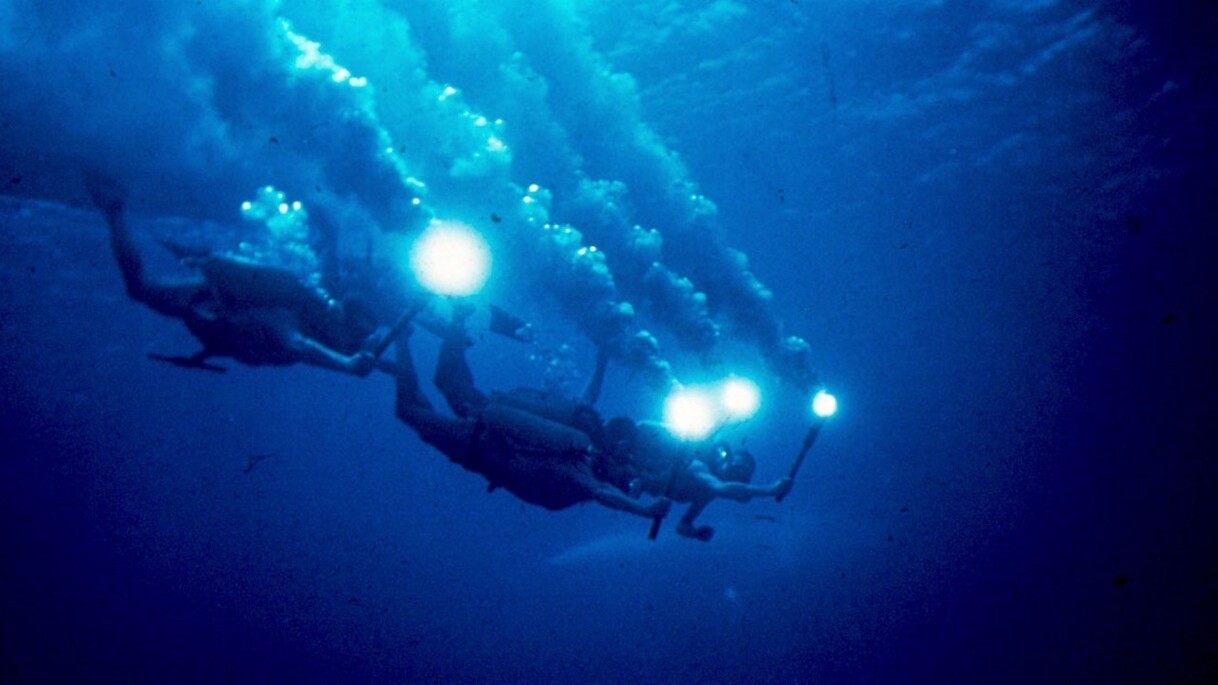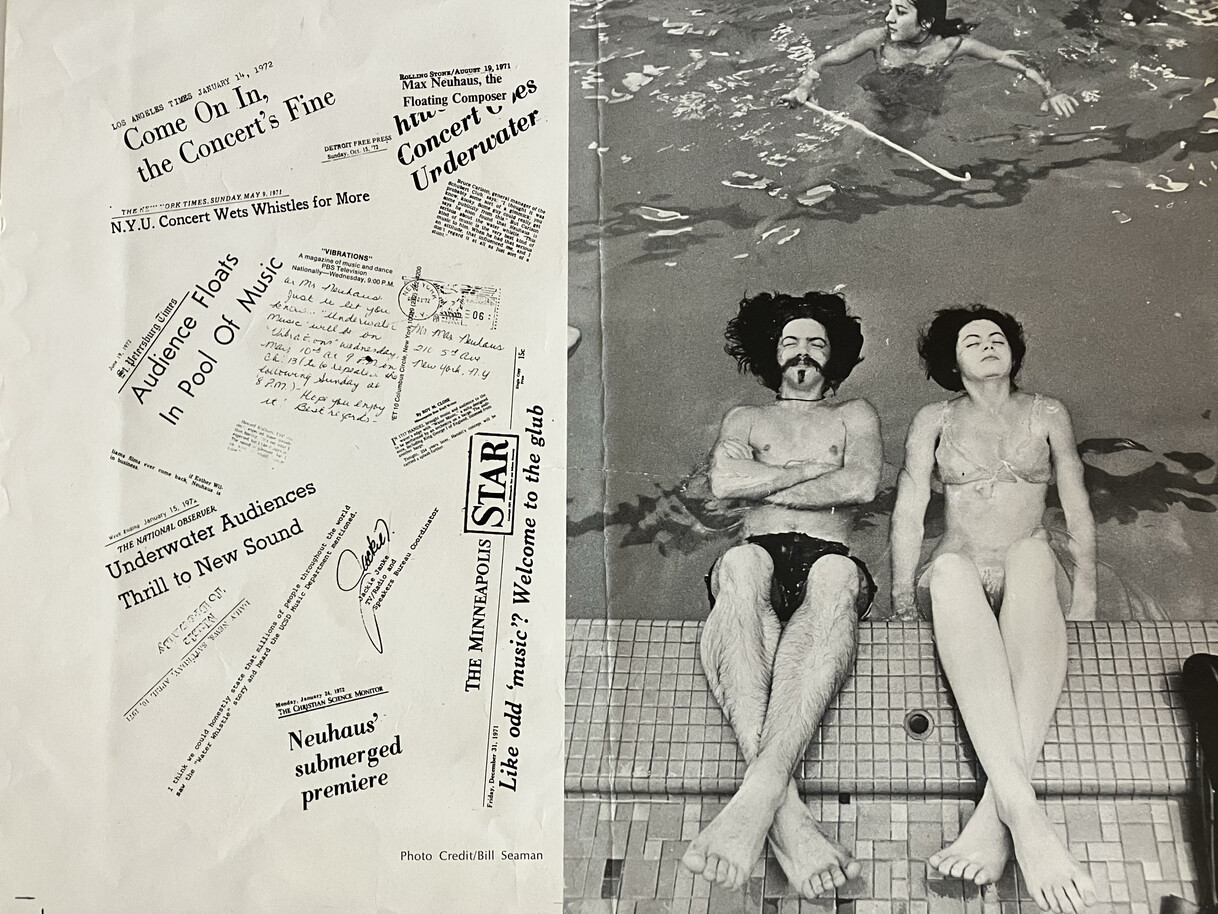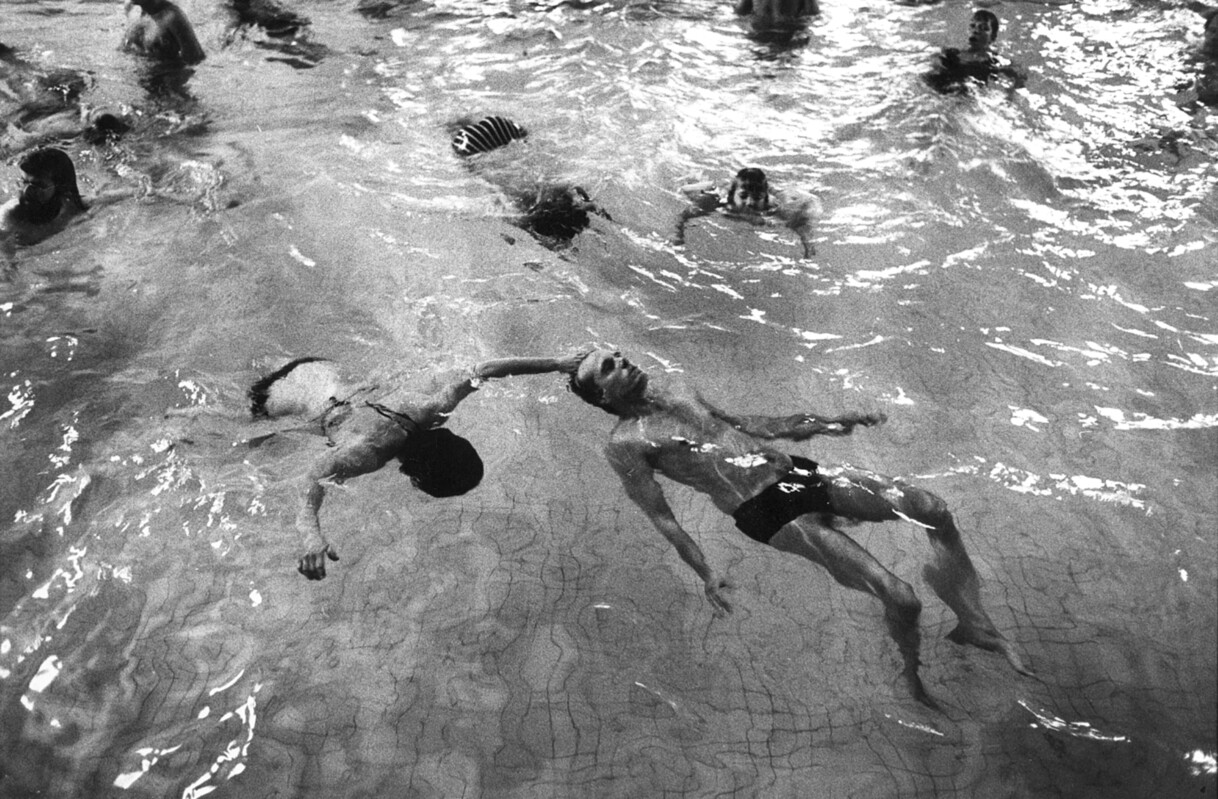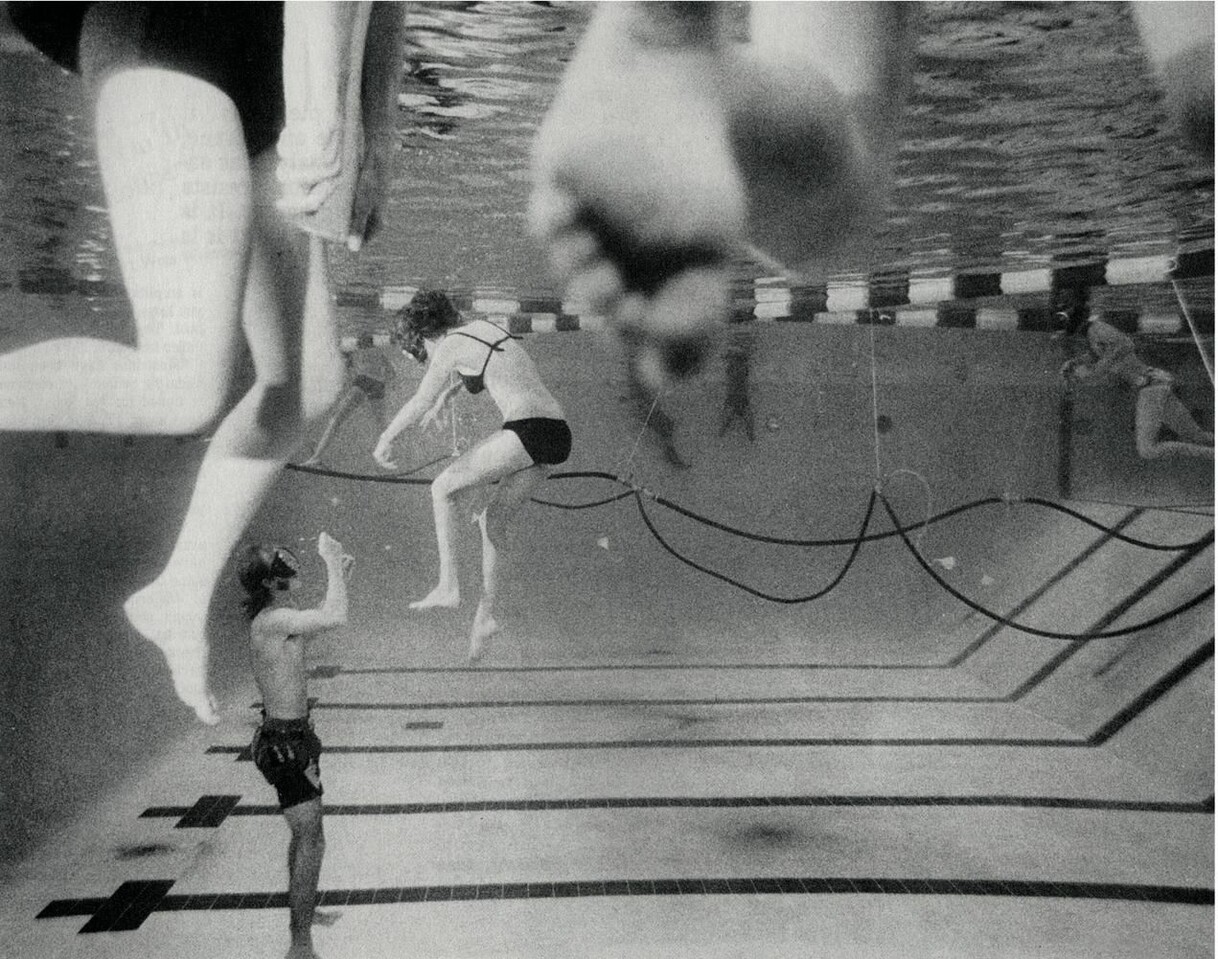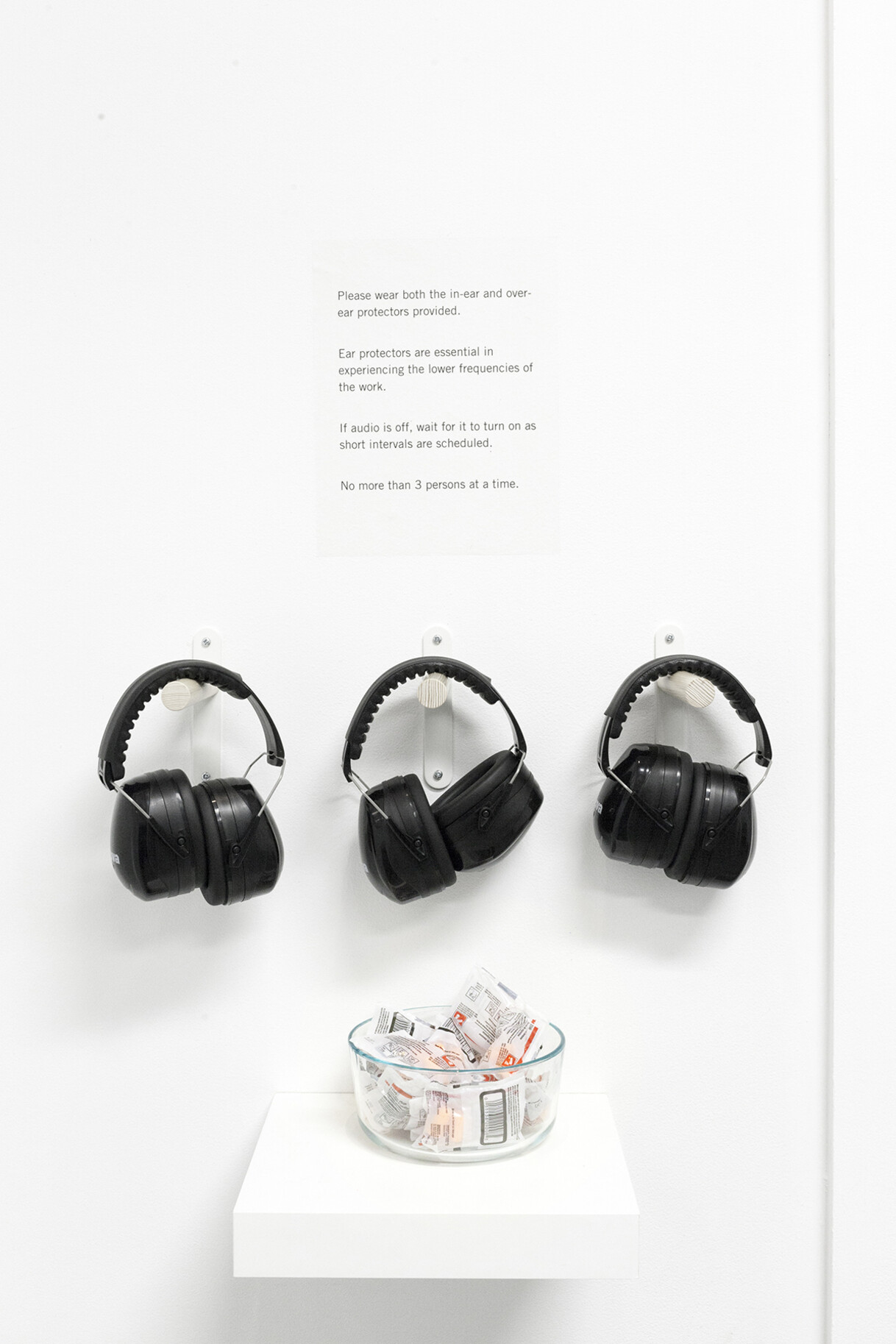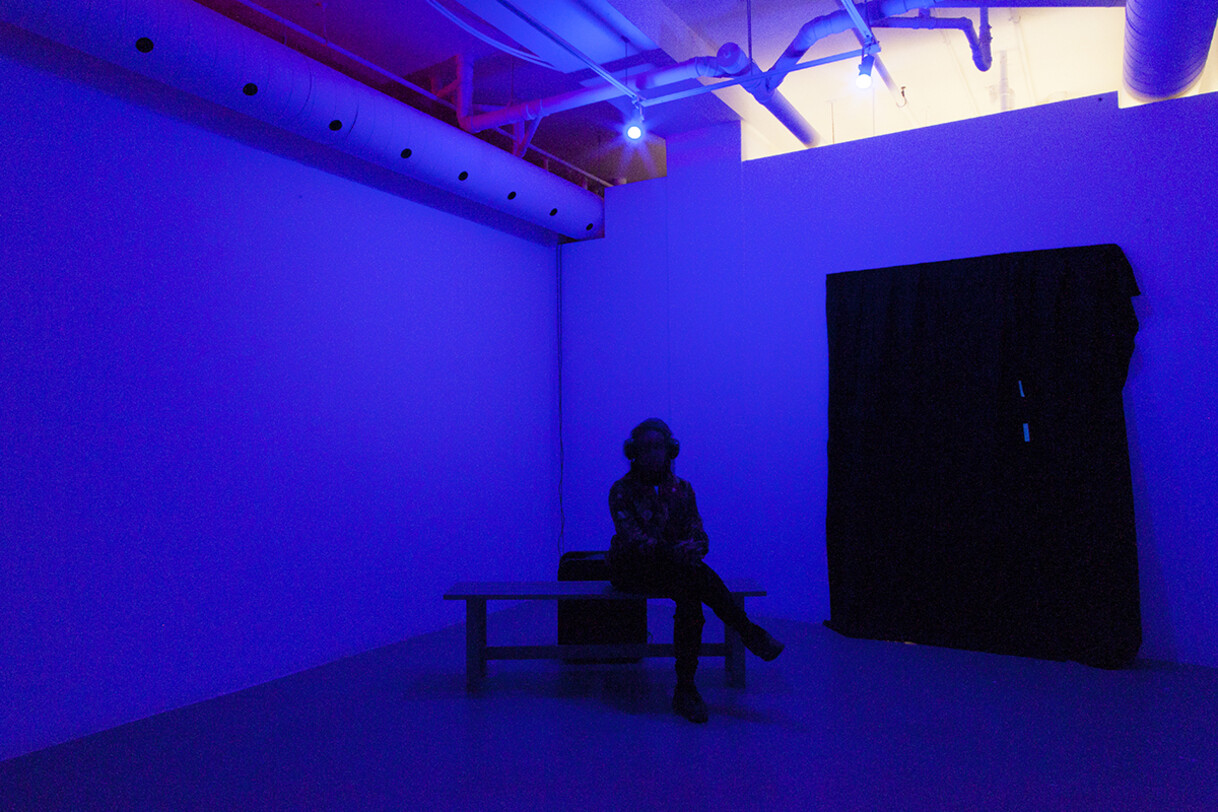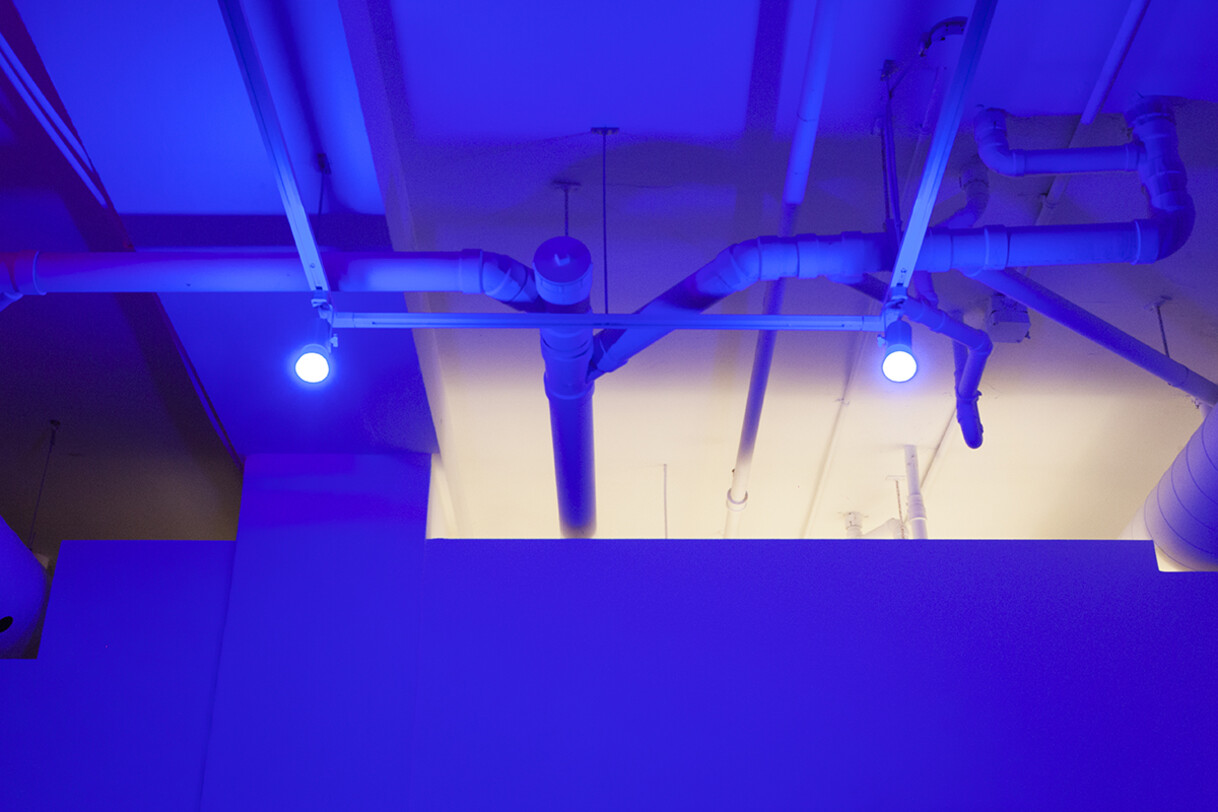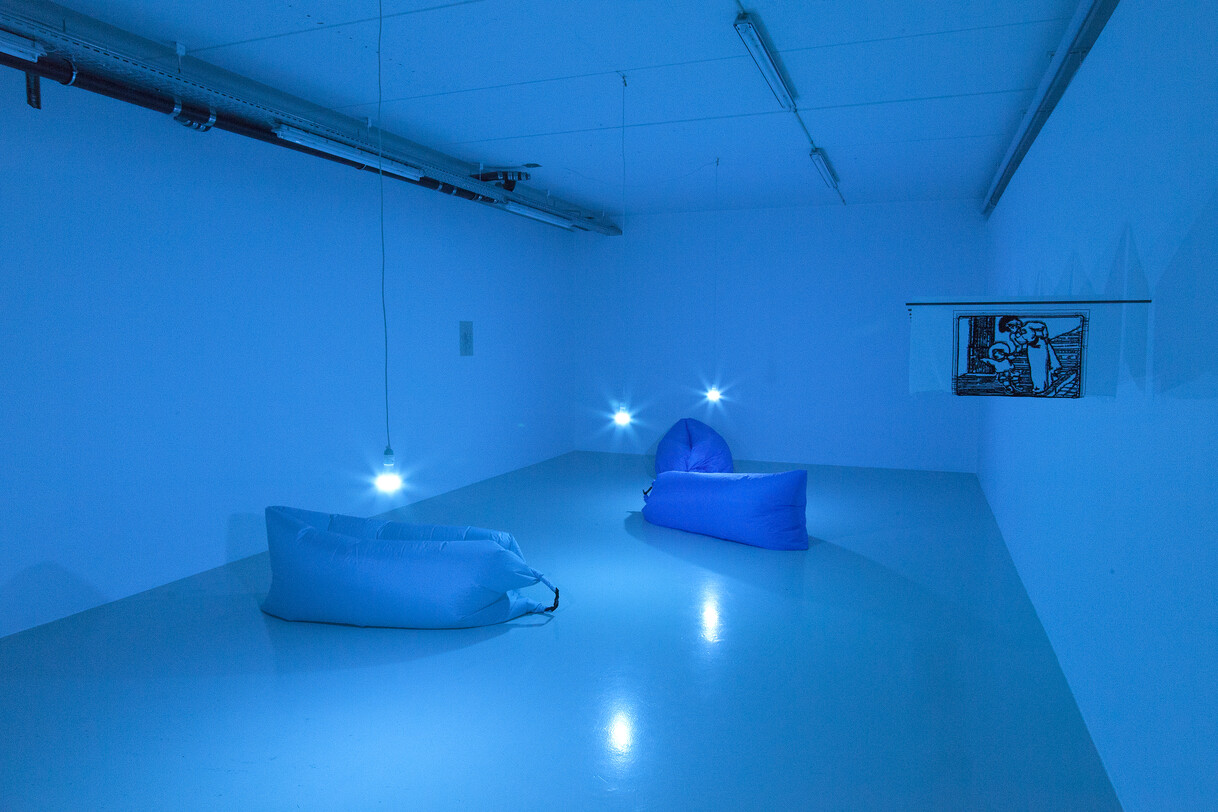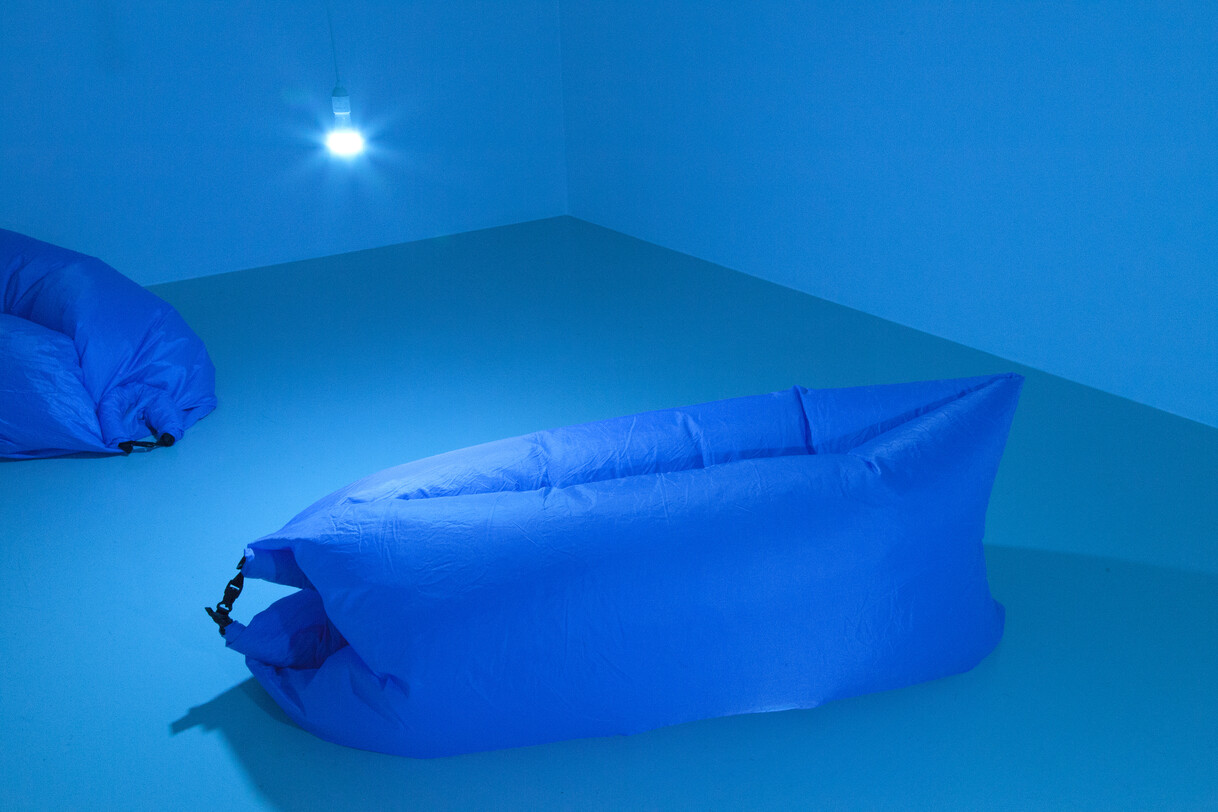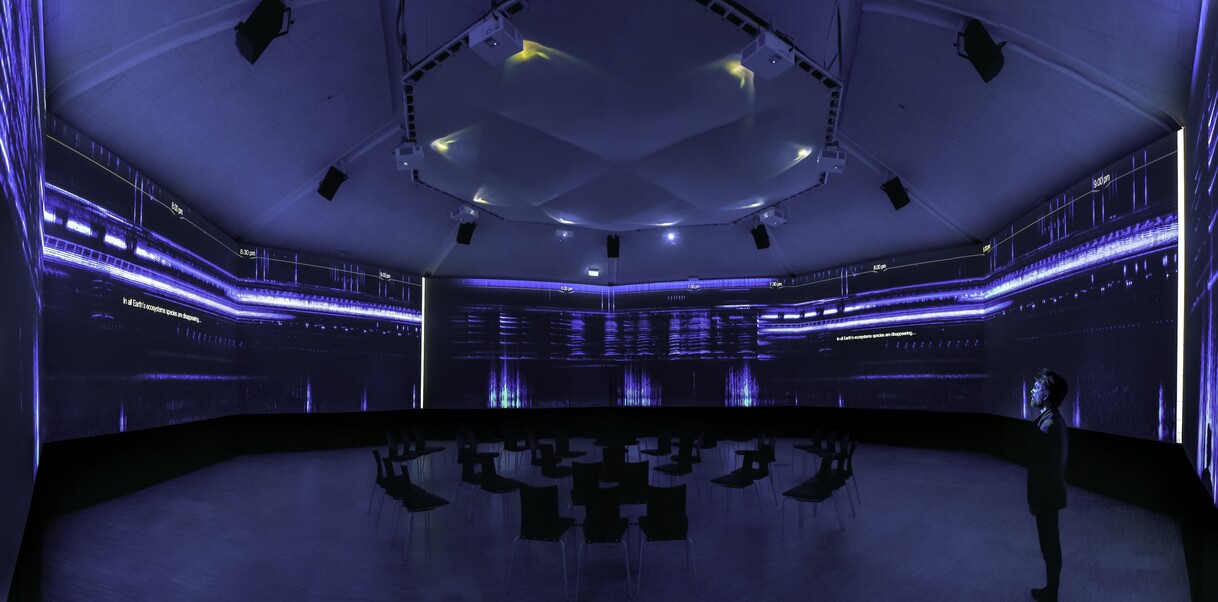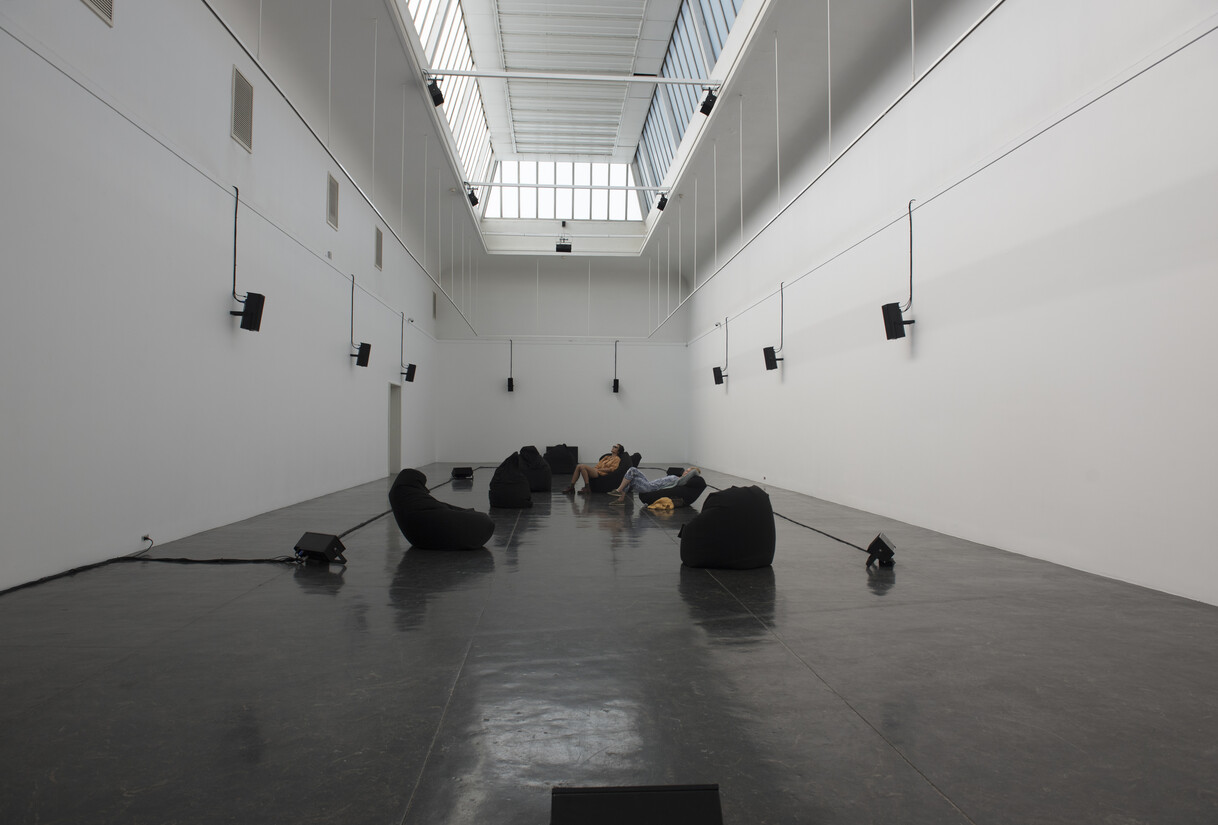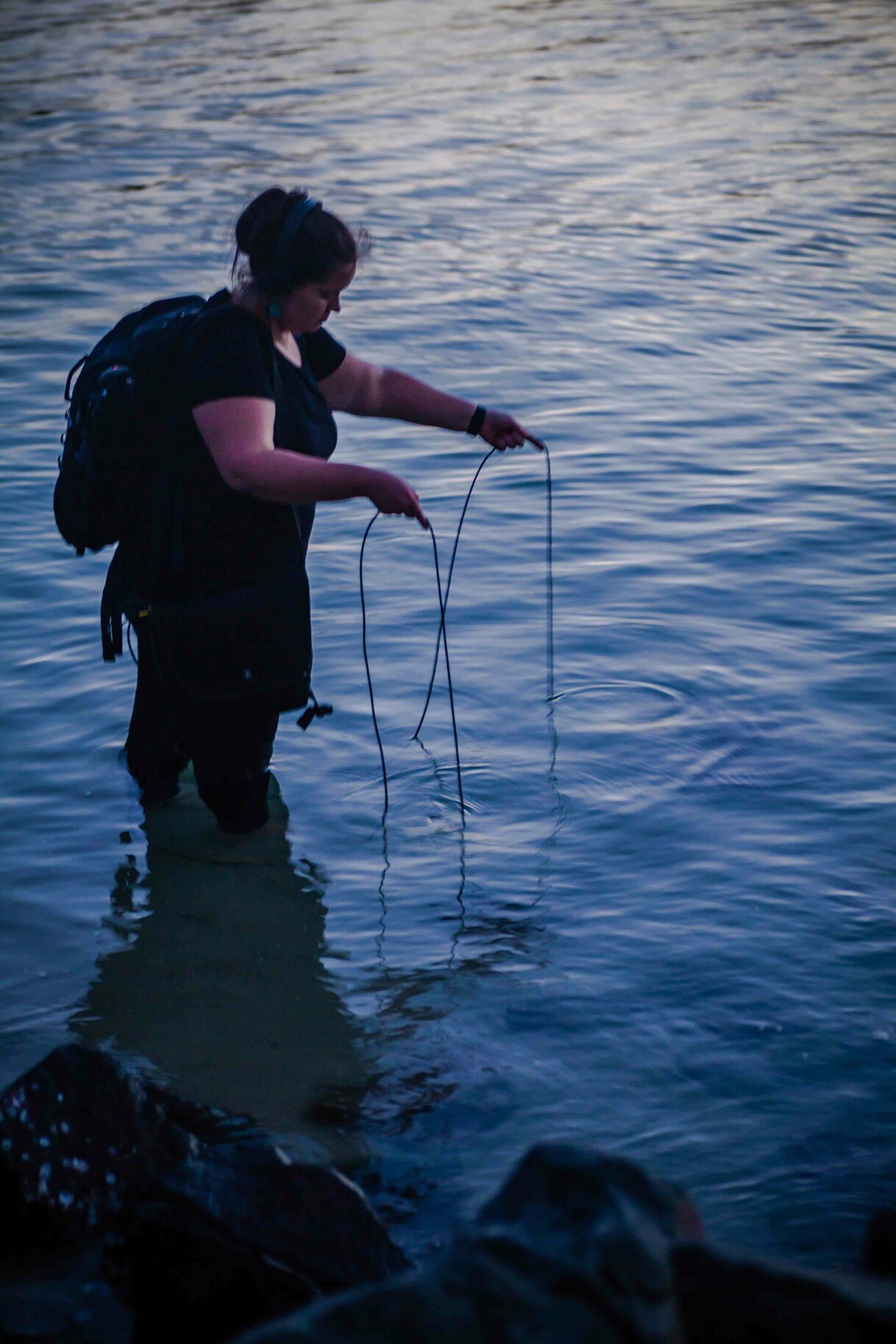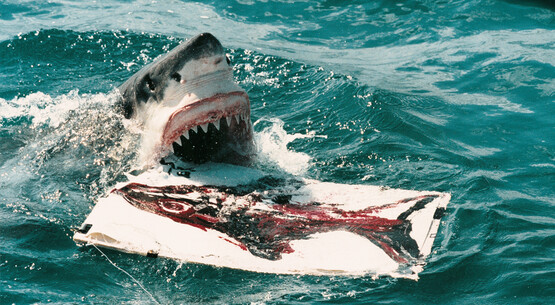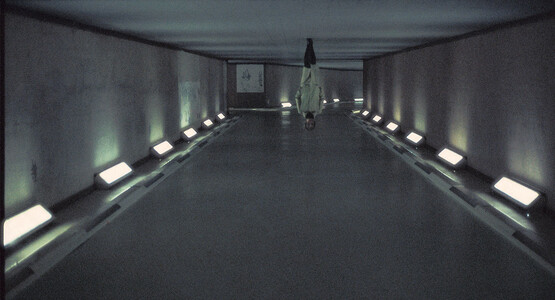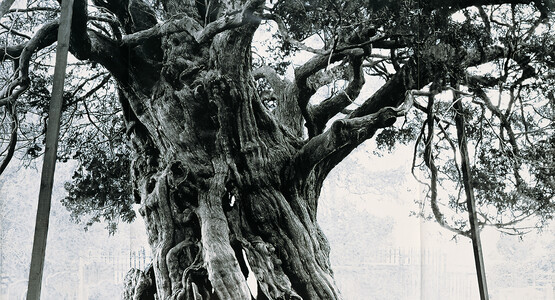Strained listening: sensing underwater noise pollution in Calder Harben’s ‘Bodies of Water’
by Chanelle Lalonde • June 2022
Aquatic environments are increasingly under threat due to a vast list of human causes, including fishing, ship traffic, chemical pollution, coastal industrialisation, offshore platforms for oil and gas extraction, offshore windfarms, naval exercises and seismic surveys for the mapping of seabed structures and for the exploitation of resources.1 These activities not only cause chemical pollution, which contaminates the marine food chain, but also noise pollution, which disrupts a variety of ecological processes in the earth’s waters. In 2017 the artist Calder Harben (b.1986) produced a sound installation titled Bodies of Water, which engages with the increasing violence of underwater noise pollution. In this immersive installation, participants encounter looped recordings of low-frequency noise pollution in a dimly lit gallery space. The work of art asks visitors to imagine the experience of marine species whose lives are dramatically disrupted by the noise produced by ships and vessels used for extractive activities, shipping commercial goods and recreational purposes. This article explores how Bodies of Water ethically engages with this issue not merely by bringing attention to it, but in its development of a listening practice that requires reckoning with the limitations of the human sensorium. It begins by examining the conditions that make hearing underwater – and sensing more broadly – difficult, before outlining how these perceptual challenges are translated into the work of art. Ultimately, it argues that Bodies of Water demands a listening practice that involves a process of continuous straining: a mode of listening that is not extractive, but one that embraces unfamiliarity.
Underwater acoustic worlds
There are entire worlds of sound that remain largely or completely hidden from humans and for many sound theorists and practitioners, the most intriguing of these is the ocean. Apart from the sound of waves, this is a realm that largely appears silent to those who live on land. In 1953 the oceanographer Jacques Cousteau, with Frederic Dumas, published The Silent World, a memoir about his time exploring the oceans. Three years later, he released a film version of the book by the same title FIG. 1, which was among the first to use underwater cinematography, revealing colour images of tropical fish, whales and sea creatures. Although The Silent World appeared to give the public unprecedented access to these underwater worlds, a significant component was missing: the scenes shot underwater were accompanied by an instrumental soundtrack, concealing the sonic dimensions of the space. The idea of the ocean as a ‘silent world’ has been prevalent in collective imaginaries ever since.
Humans and their modest senses do not access underwater acoustic worlds by simply penetrating the surface of water. Sound behaves very differently in the underwater realm. It travels approximately 1,500 metres per second, which is much faster than in air, where the speed is about 340 metres per second, and it can propagate for thousands of kilometres.2 In his article ‘An anthropologist underwater: immersive soundscapes, submarine cyborgs, and transductive ethnography’ the anthropologist Stefan Helmreich insisted that humans cannot navigate underwater acoustic worlds in the same way that they can manage air-filled environments. This, he explains, is in part because it is nearly impossible for humans to use underwater acoustic vibrations to locate themselves in space. In addition to sound travelling much faster than humans are accustomed to, ‘human eardrums are too similar in density to water to provide the resistance that can interrupt many underwater vibrations so that they might be translated into tympanic movement – sound – in the ears’.3 Instead, many vibrations underwater pass right through our bodies. Helmreich explains that for humans, underwater sound is mostly registered by the bones in the skull, which allows enough resistance for vibrational motions to be conducted into resonances in the body. This has a profound effect on how sound is sensed by humans submerged in water:
Conduction of sound by bone directly to the inner ear confounds any difference in signals received by left and right ears […] Unaided human ears perceive underwater sound as omniphonic: coming from all directions at once (and, indeed, because of sound’s seemingly instantaneous arrival, often as emanating from within one’s own body).4
Helmreich does not suggest that humans do not experience sound as they dive into a body of water, but rather maintains that the way in which they sense and interpret sound is vastly different from the way they experience sound on earth.
This phenomenon became a subject of interest and experimentation for such artists as Max Neuhaus (1939–2009), who began a series of works titled Water Whistle in 1971. The series consisted of sound installations for which listeners were invited to immerse themselves and swim in pools brimming with water FIG. 2. From 27th to 30th September 1978, De Appel, Amsterdam, hosted a sound installation and series of events by Neuhaus titled Under water music(s) / Water Whistle FIG. 3 FIG. 4 for which participants were asked to bring their bathing suits. In photographs documenting these events we see participants swimming and floating in the pool FIG. 5. What we do not see – or rather hear – is, of course, what the participants were listening to, namely the sound textures fabricated by Neuhaus that could only be heard underwater. These were created by a series of hoses forcing water through whistles to make pitched sounds.5 In the written invitation for the event, Neuhaus explained that in water ‘sound travels much faster and further’ and that ‘we hear not only with our ears but also with our foreheads; our whole sense of sound location is changed’. In his article on Neuhaus’s legacy, Walter Cianciusi describes how ‘the unexpected character of the sound’ in this installation was seductive and magical. He wrote that because of the way the forehead transmits sound waves to the ears underwater, it felt as though the sources of the whistle sounds were inside the body; it was an ‘all-encompassing sensation’.4
What is clear is that as humans submerge their bodies in water, seemingly breaking the barrier between terrestrial and aquatic acoustic worlds, the ways in which they physiologically experience sound and navigate underwater is destabilising. Parts of this complex acoustic world always remain hidden or distorted. Even with sophisticated technological devices that permit listening across different environments, our access to underwater acoustic worlds remains partial. Helmreich explains that for underwater soundscapes to become audible for humans in air environments, equipment must first be constructed that can capture and transform underwater vibrations in the audio register. Hydrophones, for example, are devices that can sense underwater vibrations; they are usually equipped with a microphone made of ceramic or another material that is sufficiently denser than water, allowing propagating sound waves to be impeded. Once sound has been received by a hydrophone, signals are transported into an airy medium for apprehension by human ears. Such sounds can be rendered using stereo devices that transform signals arriving at underwater receivers into binaurally centred impressions in headphones or speakers, ultimately ‘translating captured submarine sound into spatial relations dimensionally meaningful to hearing humans’.7 In short, accessing underwater acoustic worlds is not as simple as penetrating the water’s surface with our bodies, and unaided ears, or even with our technological equipment, such as hydrophones.
It is also worth noting that there are sounds that humans do not hear because their frequency lies outside of our range. In Ecoacoustics: The Ecological Role of Sounds (2017), the bioacoustics researchers Francesco Filiciotto and Giuseppa Buscaino claim that many aquatic organisms, including marine mammals, fish and some invertebrates produce sounds with emission frequencies ranging from infrasound (sound at frequencies below what we can hear) to ultrasound (sound at frequencies above what we can hear).8 Cetaceans employ the broadest acoustic ranges of any mammal group, and can make sounds and hear in ranges from 10 hertz to 200 kilohertz, whereas human hearing is in the 20 hertz to 20 kilohertz range.9 This means that the extremely low-frequency sounds produced by ships and vessels, which humans might consider to be quiet if not silent, can dramatically disrupt marine ecosystems. As such, due to the quasi-impossibility of experiencing sound binaurally underwater and the fact that many underwater sounds exist at frequencies that exceed the human hearing range, it can be incredibly difficult for humans to recognise the significance of sounds beneath the water’s surface, including anthropogenic noise that is increasingly present in aquatic worlds. Contemporary artists such as Harben work to bring these vibrations into the gallery for the earthbound to experience.
‘Bodies of Water’
Bodies of Water has been exhibited twice: first in February 2017 at Xpace Cultural Centre, Toronto, and a second time – in a slightly modified version – in February 2019 at Vermilion Sands, Copenhagen. In both iterations those who entered the exhibition space were confronted with an ambient sound recording that was not immediately audible. The audio comprised hydrophone recordings from different underwater locations – from the Mediterranean Sea to the Gulf of Bothnia and Lake Ontario – which document the auditive consequences of industry and traffic on marine environments.10 The artist amplifies these low frequency recordings to the very threshold of human hearing and plays them through a subwoofer, a speaker typically used to augment low frequency sounds. Despite this intervention, the audio remains elusive and difficult to discern. In a text published alongside the work, Shannon Webb-Campbell, a poet and descendent of the Mi’kmaq people from the Qalipu First Nation in Newfoundland, observes that Bodies of Water requires from visitors an act of deep listening as a means of communing with the sonic depth of bodies of water, even though these low-frequency sounds are almost inaudible to humans.11
At Xpace Cultural Centre, before entering the room housing the installation, participants were provided with earplugs and a second layer of over-ear protection FIG. 6. Hung on a wall near the entrance, the ear protectors were accompanied by a wall text insisting that ‘ear protectors are essential in experiencing the low frequencies of the work’. Harben claims that this ear protection was offered as an assistive device to help listeners ‘turn off the ears’, rather than as any real form of safety guard. Although the two layers of ear protection did not isolate all sounds, they ‘allowed a quicker transition into sensing with the body’.12 In other words, the ear protection challenges the instinctive effort to sense sound binaurally, alluding to the way in which sound is experienced underwater.
Once participants covered their ears, they entered a small room bathed in a dark blue hue FIG. 7 FIG. 8. Although the dark lighting did not entirely hinder visibility, it did limit visual distractions. The dim blue lighting, also a nod to the visual experience of being submerged in water, was among the few visual elements of the work. Others included a wooden bench, a speaker and minimal wires. Together, the barely audible audio and the assistive devices in Harben’s installation pushed listeners to perceive and to feel vibrations that they otherwise would not be able to encounter, to experience sound as it rarely is. According to the artist, the longer a listener remained in the space, the more their body would become sensitised to the low-frequency sound.
At Vermilion Sands, Bodies of Water was installed in the group exhibition Bubble Metropolis. Here Harben once again played low-frequency sound recordings of underwater noise pollution. A similar, lighter blue hue filled the room FIG. 9 FIG. 10. From the ceiling, a hydrophone was hung, further situating participants in a metaphorical underwater space. This time, instead of a wooden bench, the room was equipped with several inflatable chairs, which Harben suggests provided a more comfortable arrangement, feasibly extending the experience of listening. Filled with air, these chairs also more intensely carried, rather than impeded, the vibrations and frequencies of the installation’s audio.13 In a review of Bodies of Water as it was displayed in Bubble Metropolis, Kristian Vistrup Madsen wrote that ‘listening inflicts a certain pain, as the soundscape becomes indistinguishable from your own heartbeat and the thudding of the hearing protection against your temples’. Vistrup Madsen explains that the vibrations in the space created a ‘slow, sickening rumble’ that we might imagine could be felt in the depths of the bodies of water in which the audio was recorded.14
Strained listening
Harben’s installation emerged alongside a growing number of works of art using sound to address today’s ecological crisis. In 2017 the writer and electroacoustic composer Jonathan Gilmurray proposed ‘ecological sound art’ as a new field of environmentally concerned art, noting that an increasing number of artists – such as Leah Barclay (b.1985), David Monacchi (b.1970) FIG. 11, Matthew Burtner (b.1971), Andrea Polli (b.1968), David Dunn (b.1953) and Jana Winderen (b.1965) FIG. 12 – are using sound as a medium to creatively engage with contemporary environmental issues in the twenty-first century. In his article, ‘Ecological sound art: steps towards a new field’, Gilmurray outlines some of the core approaches that characterise recent works of ecological sound art and discusses the pertinence of sound for approaching such issues as climate change, biodiversity loss and pollution. By drawing on the work of contemporary ecological theorists, including Timothy Morton, David Abram and Jane Bennett, he contends that ‘one of the fundamental pillars of ecological theory is the principle of interconnectedness between the different elements within the earth’s ecosystems’ and that the interlocking behaviour of sound emulates this.15 The sound artist and researcher Leah Barclay upholds this view, claiming that ‘sound has incredible abilities to provide embodied sensory engagement’ and that active listening ‘can evoke profound interconnection and empathetic responses’.16
Barclay notes that many ecological sound artists work in highly interdisciplinary contexts, often using field recordings to create interactive installations that highlight the value of acoustic ecology – an ‘interdisciplinary framework for documenting, analyzing, and transforming sonic environments’, which emerged with R. Murray Schafer’s The Tuning of the World in 1977.17 For Barclay, field recordings and works of art that integrate them can ‘provide opportunities for the general public to explore sound worlds they would not necessarily have access to’.18 Many of her projects, such as Hydrology (2017) and WIRA (2015), involve recording underwater environments with hydrophones FIG. 13, which amplify the sounds emitted by aquatic insects, snapping shrimp, fish and other species. She proposes that ‘the impacts of climate change and ecological disturbances are often very visible in terrestrial environments, yet dramatic changes in aquatic ecosystems can go unnoticed simply due to visibility – we simply cannot see beneath the surface’.19 In response to this, Barclay’s works aim to make accessible imperceptible underwater sounds to urban dwellers with the help of mobile technologies and geo-located sound clips. In her sound installation WIRA, for instance, such sound recordings were made available through an app and could be experienced by walking along the river with a smart phone and earphones. Each recording was geotagged in relation to a relevant part of the river bank – for example, a recording of snapping shrimp becomes louder as one approaches the jetty, closer to where the shrimp are located. By engaging people with the sound recordings in this way, Barclay performs the important work of unveiling bodies of water as vibrant and changing environments, which require our attention and empathy.
Like Barclay, Harben’s process involves producing underwater audio recordings with hydrophones and later disseminating them in the context of interactive sound installations. However, Bodies of Water is different in that it complicates such notions of connection and access. The low-frequency recordings in this work, because they have been amplified only to the threshold of human perception, prevent listeners from accessing the audio in ways that are instinctive. Although the idea that aquatic environments are intensely filled with sound is undeniably maintained in this work of art, the listener’s ability to access it is called into question. By provocatively asking us to listen to what is barely audible, Harben’s installation prompts us to search for new ways of listening.
In the exhibition catalogue for Hlysnan: The Notion and Politics of Listening, the curator Berit Fischer explains that the Old English word hlysnan, which means ‘to listen’, ‘refers to an active act not merely of hearing, but of hearing with intent’.20 This simple distinction echoes the writings of Jean-Luc Nancy, in particular his claim that ‘every sensory register […] bears with it both its simple nature and its tense, attentive, or anxious state: seeing and looking, smelling and sniffing or scenting, tasting and savoring, touching and feeling or palpating, hearing and listening’.21 Indeed, the idea of listening as unconnected to access, deduction, resolution and certainty, but instead connected to tension, attention and uncertainty is productive for considering the experience of listening staged by Harben in Bodies of Water.
Nancy further outlines that entendre (to hear) also means comprendre (to understand): ‘as if “hearing” were above all “hearing say” (rather than “hearing sound”), or rather, as if in all “hearing” there had to be a “hearing say”, regardless of whether the sound perceived was a word or not’. Nancy argues that ‘there is hearing, and in hearing itself, at the very bottom of it, a listening’. But what exactly does the philosopher mean when he speaks of listening? He proposes that it entails a process of straining; that to listen is to tendre l’oreille, which translates as ‘to stretch the ear’, and thus implies an intensification, a curiosity and even an anxiety. More precisely, to listen is to strain ‘toward a possible meaning, and consequently one that is not immediately accessible’.22 What Harben produces with Bodies of Water is a space in which an act of straining is provoked; participants strain to sense a recording that is not readily or easily sensible.
In both locations, as the visitor enters Harben’s installation, wearing the provided over-ear protection, they become aware that they are about to come into contact with sound. They wait for the sound to emerge but then realise that it is already present; it is subtle and hard to detect. Hence, from the moment they enter the room, they are immediately immersed in the vibrations of the low-frequency sound to which most human ears are not accustomed. Listeners strain their ears, desperate to understand, eager for the sound to further reveal itself. They continue to wait, perhaps searching for new ways of listening. The ear protection is useful in this regard as, for Harben, to ‘turn off the ears’ allows for a quicker transition into listening with the body.23 Even if the sound was more audible, the ear protection prevents listeners from clearly hearing it – straining to hear, they think about how their entire body responds to this encounter with sound.
Despite the assistance provided by Harben in sensing a sound that is normally out of reach, there is an anticipation that never quite dissipates. The low-frequency sound teases the senses, bringing the listener to recognise it as sound, albeit one that must be experienced not with the ears, but with the body. This phenomenological exercise is somewhat reminiscent of Neuhaus’s Water Whistle, insofar as it contemplates the different conditions of sound underwater. However, Bodies of Water, which emerged decades later, at a time in which the ecological crisis has infiltrated collective consciousness, goes further by embracing strained listening more specifically as a means through which to ethically relate to the marine species who are deeply affected by anthropogenic noise pollution.
Bodies of Water is not merely a phenomenological exercise aimed at testing the limits of human perception. It does this while also, crucially, bringing attention to increasingly threatened aquatic environments. In the gallery, listeners are figuratively submerged in a body of water. As previously mentioned, the recordings play in a room filled with a dim blue hue that alludes to underwater light conditions. The title reinforces this watery setting, as does the accompanying text by Webb-Campbell, which addresses the provenance and content of the recordings. The text outlines that what listeners encounter in the gallery space are hydrophone recordings documenting the auditive consequences of industry and traffic on marine environments. The decision to seemingly locate listeners underwater is significant for conceiving the work’s contribution in the field of ecological sound art.
Like the audio in the installation itself, underwater environments tend to be elusive. Barclay proposes that this is why dramatic changes in aquatic ecosystems are much easier to ignore than those in terrestrial environments. For the sound artist and theorist Brandon LaBelle, who explores the potential of listening as a form of activism in the publication Sonic Agency: Sound and Emergent Forms of Resistance, listening has intrinsic value as a form of recognition. Following what Anna Tsing calls the ‘art of noticing’, LaBelle explores listening as a mode of engagement with that which is difficult to grasp, notably in such works as The Open Body (monster) FIG. 14. Listening, according to LaBelle, can ‘perform to create a gap, a duration drawn out, detouring the flows of normative actions’. The figure of the listener is one who ‘enacts attention or considerations, and, in doing so, nurtures the conditions for mindful engagement’.24 In their constructed environment, Harben, by inviting people to listen, establishes that underwater acoustic worlds are worthy of human attention and care, even if we are not entirely equipped to perceptually access them.
While it may seem counterintuitive to limit access to the selected sound recordings, Harben’s approach can be considered a provocative and, arguably, an ethical one. The experience of strained listening generated by Bodies of Water evokes the notion that there are sounds and ways of sensing that are beyond human access. Scholars in the environmental humanities are increasingly proposing that recognising these limits, and accepting the incommensurability of the earth, can help us develop more ethical modes of engagement and aesthetics. Jennifer Gabrys, for example, has suggested that we ‘become planetary’: the planetary, she writes, ‘remains that which cannot be fixed or settled’, it resists representation. For Gabrys, ‘to know the planet can be a way to fix it as a figure of analysis and management’, which can ‘be seen to be a way to rid the planet of alterity: to make it knowable and so manageable within a universal science’.25 She proposes that we engage with the planetary not as a uniform or fixed set of conditions, but instead as that which signals conditions of difference. The experience of strained listening in Harben’s installation adheres to such conceptions of ecological ethics, as it establishes underwater sound worlds as that which cannot be easily or ever entirely grasped by humans.
Bodies of Water provides a model for ethical engagement with aquatic environments by first directing attention and consideration towards increasingly threatened underwater sound worlds, and then refusing to offer any semblance of uninterrupted access. By simulating an underwater environment, Harben’s work exposes listeners to recordings of low-frequency noise pollution that, over time, can create an uncomfortable, sickening sensation. This invites listeners to empathise with the whales and other species whose communication systems are violently disrupted by invasive noise pollution. The work provokes reflections on what it might be like to listen to what we are typically unable to sense; to listen to what is difficult to perceive; to reflect on how we relate to nonhuman bodies and on how aquatic beings experience the consequences of human activity. Simply because we cannot hear something, does not mean that we should not listen to it.





